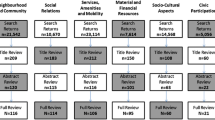Abstract
Addressing the causes and consequences of social exclusion represents a key theme in European social policy, reflecting growing awareness of the social costs which arise when individuals, families and communities become cut off from wider society. Conceptually, however, social exclusion remains underexplored in gerontology. The article suggests that exclusion represents a useful means of exploring the situation of older people in different environmental settings. Social exclusion in old age is conceptualised as a multi-dimensional phenomenon comprising of: exclusion from material resources; exclusion from social relations; exclusion from civic activities; exclusion from basic services; and neighbourhood exclusion. Drawing on a survey of 600 people aged 60 and over in deprived neighbourhoods of three English cities, the article develops indicators to represent each dimension of exclusion and seeks to assess the nature of social exclusion faced by older people in deprived neighbourhoods. Results reveal a considerable proportion of older people experiencing social exclusion in at least one form. The sample fell into three categories: 33% were not excluded on any of the five domains; 31% experienced exclusion on a single domain; 36% were vulnerable to the cumulative impact of multiple forms of exclusion. Multiple social exclusion was significantly correlated with respondents’ ethnic origin, educational status, housing tenure, perceived health status and quality of life. It is concluded that social exclusion represents a useful means of depicting disadvantage experienced by older people living in deprived urban neighbourhoods, and that it would be useful to extend the analysis to other types of residential setting.
Similar content being viewed by others
References
Arber S, Ginn J (1991) Gender and later life: a sociological analysis of resources and constraints. Sage, London
Arber S, Ginn J (eds) (1999) Connecting gender and ageing: a sociological approach. Open University Press, Buckingham
Atkinson AB (1998) Social exclusion, poverty and unemployment. In: Atkinson AB, Hills J (eds) Exclusion, employment and opportunity. Centre for Analysis of Social Exclusion, London School of Economics, London, CASEpaper 4, pp 1–20
Atkinson R, Davoudi S (2000) The concept of social exclusion in the European Union: context, development and possibilities. J Common Market Stud 38:427–448
Bauman Z (1998) Work, consumerism and the new poor. Open University Press, Buckingham
Berghman J (1997) The resurgence of poverty and the struggle against exclusion: a new challenge for social security? Int Social Security Rev 50:3–23
Bhalla A, Lapeyre F (1997) Social exclusion: towards an analytical and operational framework. Dev Change 28:413–433
Burchardt T (2000) Social exclusion: concepts and evidence. In: Gordon D, Townsend P (eds) Breadline Europe: the measurement of poverty. Policy Press, Bristol, pp 385–405
Burchardt T, Le Grand J, Piachaud D (2002) Degrees of exclusion: developing a dynamic, multidimensional measure. In: Hills J, Le Grand J, Piachaud D (eds) Understanding social exclusion. Oxford University Press, Oxford, pp 30–43
Burgess S, Propper C (2002) The dynamics of poverty in Britain. In: Hills J, Le Grand J, Piachaud D (eds) Understanding social exclusion. Oxford University Press, Oxford, pp 44–61
Butt J, Moriarty J (2004) Social support and ethnicity in old age. In: Walker A, Hagan Hennessy C (eds) Growing older: quality of life in old age. Open University Press, Basingstoke, pp 167–188
Byrne D (1999) Social exclusion. Open University Press, Buckingham
Callahan JJ (1992) Aging in place. Generations 16:5–6
Chivite-Matthews N, Maggs P (2002) Crime, policing and justice: the experience of older people. Findings from the British Crime Survey, England and Wales 08/02. Research, Development and Statistics Directorate, Home Office, London
Coulthard M, Walker A, Morgan A (2002) People’s perceptions of their neighbourhood and community involvement. Results from the Social Capital Module of the General Household Survey 2000. Office for National Statistics, Stationary Office, London
Darton D, Strelitz J (eds) (2003) Tackling UK poverty and disadvantage in the twenty-first century. Joseph Rowntree Foundation, York
De Jong Gierveld J, Kamphuis FH (1985) The development of a Rasch-type loneliness-scale. Appl Psychol Measure 9:289–299
De Jong Gierveld J, van Tilburg T (1999) Cesuurbepaling van de eenzaamheidsschaal (Cutting scores on the De Jong Gierveld loneliness scale). Tijdschr Gerontol Geriatr 30:158–163
Department of the Environment, Transport and the Regions (1998) Updating and revising the Index of Local Deprivation. Stationery Office, London
Department for Work and Pensions (2001) United Kingdom National Action Plan on Social Inclusion 2001–2003. Stationery Office, London
Diener E, Emmons RA, Larson RJ, Griffin S (1985) The satisfaction with life scale. J Personality Assess 49:71–75
Evandrou M (2000) Social inequalities in later life: the socio-economic position of older people from ethnic minority groups in Britain. Population Trends Autumn, pp 11–18
Forrest R (2004) Who cares about neighbourhoods? ESRC Centre for Neighbourhood Research, University of Bristol, Bristol, CNR Pap 26
Gans HJ (1972) People and plans. Essays on urban problems and solutions. Penguin, Harmondsworth
Glennerster H, Lupton R, Noden P, Power A (1999) Poverty, social exclusion and neighbourhood: studying the area bases. Centre for Analysis of Social Exclusion, London School of Economics, London, CASEpaper 22
Gordon D, Adelman L, Ashworth K, Bradshaw J, Levitas R, Middleton R, Pantazis C, Patsios D, Payne S, Townsend P, Williams J (2000) Poverty and social exclusion in Britain. Joseph Rowntree Foundation, York
Griffiths C, Fitzpatrick J (eds) (2001a) Geographic variations in health. Office for National Statistics, Stationery Office, London
Griffiths C, Fitzpatrick J (eds) (2001b) Geographic inequalities in life expectancy in the United Kingdom, 1995–97. Health Stat Q 9:16–28
Hills J (1995) Income and wealth, vol 2: a summary of the evidence. Joseph Rowntree Foundation, York
Hills J, Le Grand J, Piachaud D (eds) (2002) Understanding social exclusion. Oxford University Press, Oxford
Lawton MP (1975) The Philadelphia Geriatric Center Morale Scale: a revision. J Gerontol 30:85–89
Leisering L, Walker R (eds) (1998) The dynamics of modern society. Policy Press, Bristol
Levitas R (1998) The inclusive society? Social exclusion and New Labour. Macmillan, Basingstoke
Leyland AH (2004) Increasing inequalities in premature mortality in Great Britain. J Epidemiol Community Health 58:296–302
Lupton R, Power A (2002) Social exclusion and neighbourhoods. In: Hills J, Le Grand J, Piachaud D (eds) Understanding social exclusion. Oxford University Press, Oxford, pp 118–140
Mack M, Lansley S (1985) Poor Britain. George Allen and Unwin, London
Madanipour A, Cars G, Allen J (eds) (1998) Social exclusion in European cities: processes, experiences, and responses. Jessica Kingsley, London
Marcuse P (1996) Space and race in the post-fordist city. In: Mingione E (ed) Urban poverty and the underclass: a reader. Blackwell, Oxford
Means R (1997) Home, independence and community care: time for a wider vision? Policy Politics 25:409–419
Minkler M, Estes C (eds) (1999) Critical gerontology. Baywood, New York
Murie A, Musterd S (2004) Social exclusion and opportunity structures in European cities and neighbourhoods. Urban Stud 41:1441–1459
Nazroo J, Bajekal M, Blane D, Grewal I (2004) Ethnic inequalities. In: Walker A, Hagan Hennessy C (eds) Growing older: quality of life in old age. Open University Press, Basingstoke, pp 35–59
Neighbourhood Renewal Unit (2003) Research Report 7. New Deal for Communities. The National Evaluation Annual Report 2002/03. Office of the Deputy Prime Minister, Stationery Office, London
Office for National Statistics (2004) Social Trends 34. Stationery Office, London
Phillipson C (1998) Reconstructing old age. Sage, London
Phillipson C, Scharf T (2004) The impact of government policy on social exclusion of older people: a review of the literature. Social Exclusion Unit, Office of the Deputy Prime Minister, Stationery Office, London
Phillipson C, Bernard M, Phillips J, Ogg J (1999) Older people’s experiences of community life: patterns of neighbouring in three urban areas. Sociol Rev 47:715–743
Phillipson C, Bernard M, Phillips J, Ogg J (2000) Family and community life of older people. Routledge, London
Power A (2000) Poor areas and social exclusion. Centre for Analysis of Social Exclusion, London School of Economics, London, CASEpaper 35
Rowles GD (1978) Prisoners of space? Exploring the geographical experience of older people. Westview, Boulder, CO
Scharf T, Phillipson C, Kingston P, Smith AE (2001) Social exclusion and older people: exploring the connections. Education Ageing 16:303–320
Scharf T, Phillipson C, Smith A, Kingston P (2002) Growing older in socially deprived areas. Help the Aged, London
Scharf T, Phillipson C, Smith AE (2005) Multiple exclusion and quality of life amongst excluded older people in disadvantaged neighbourhoods. Social Exclusion Unit, Office of the Deputy Prime Minister, Stationery Office, London
Shaw M, Dorling D, Davey Smith G (2001) Mind the gap: inequalities continue to widen under New Labour. Townsend Centre for International Poverty Research, University of Bristol, Bristol
Sheldon JH (1948) The social medicine of old age. Oxford University Press, Oxford
Silver H (1994) Social exclusion and social solidarity: three paradigms. Int Labour Rev 133:531–578
Sin CH (2004) Sampling minority ethnic older people in Britain. Ageing Soc 24:257–277
Smith AE, Sim J, Scharf T, Phillipson C (2004) Determinants of quality of life amongst older people in deprived neighbourhoods. Ageing Soc 24:793–814
Social Exclusion Unit (1998) Bringing Britain together: a national strategy for neighbourhood renewal. Stationery Office, London
Social Exclusion Unit (2001) A new commitment to neighbourhood renewal. Stationery Office, London
Speak S, Graham S (2000) Private sector service withdrawal in disadvantaged neighbourhoods. Findings 230. Joseph Rowntree Foundation, York
Strelitz J, Darton D (2003) Tackling disadvantage: place. In: Darton D, Strelitz J (eds) Tackling UK poverty and disadvantage in the twenty-first century. Joseph Rowntree Foundation, York, pp 91–103
Tanner D (2001) Sustaining the self in later life: supporting older people in the community. Ageing Soc 21:255–278
Townsend P (1957) The family life of old people. Routledge and Kegan Paul, London
Townsend P (1979) Poverty in the United Kingdom. Penguin, Harmondsworth
Townsend P (1981) The structured dependency of the elderly: the creation of policy in the twentieth century. Ageing Soc 1:5–28
Tunstall J (1966) Old and alone. Routledge and Kegan Paul, London
Victor CR, Scambler S, Bond J, Bowling A (2000) Being alone in later life: loneliness, social isolation and living alone. Rev Clin Gerontol 10:407–417
Victor CR, Scambler S, Shah S, Cook DG, Harris T, Rink E, Wilde S de (2002) Has loneliness amongst older people increased? An investigation into variations between cohorts. Ageing Soc 22:1–13
Walker A (1998) Speaking for themselves: the new politics of old age in Europe. Education Ageing 13:125–142
Walker A (2004) Quality of life in old age in Europe. In: Walker A (ed) Growing older in Europe. Open University Press, Buckingham, pp 1–29
Young M, Willmott P (1957) Family and kinship in East London. Routledge, Harmondsworth
Acknowledgements
Funding for the research was provided by the Economic and Social Research Council (ESRC) under the Growing Older Programme (grant no. L480254022).
Author information
Authors and Affiliations
Corresponding author
Rights and permissions
About this article
Cite this article
Scharf, T., Phillipson, C. & Smith, A.E. Social exclusion of older people in deprived urban communities of England. Eur J Ageing 2, 76–87 (2005). https://doi.org/10.1007/s10433-005-0025-6
Published:
Issue Date:
DOI: https://doi.org/10.1007/s10433-005-0025-6




